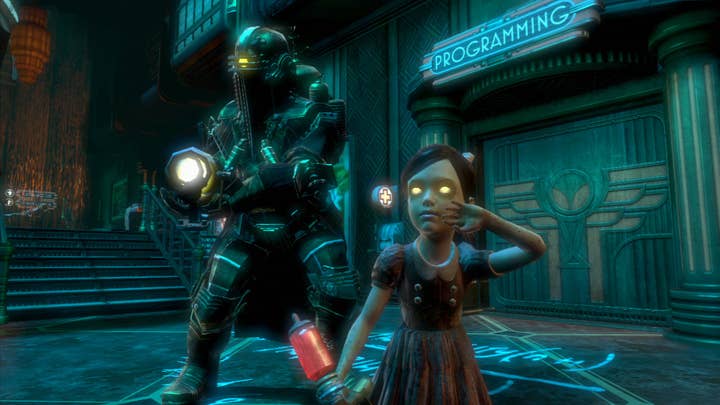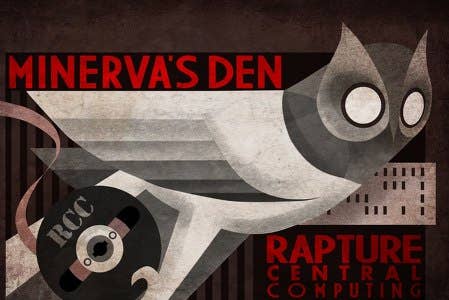The Fullbright Company: Non-Combat Ready
Three Bioshock veterans using the unique advantages of 21st Century development to take the "shooter" out of first-person shooter
In recent years, the notion that this is the best time to be an indie developer since the industry formed has become commonplace, and with good reason. New platforms abound, most of them with low development costs and simple, rapid methods of distribution. A small handful of these are now worth billions of dollars every year, and have taken their pound of flesh from the monolithic companies that helped to stifle grass-roots development for so long. Contemporary indies still face difficulties, of course, but their options have seldom been more abundant, their channels of communication seldom more open, and their chances of earning a decent living all the more promising as a result.
In that sense, The Fullbright Company is a true product of the times. Founded by Steve Gaynor, Johnnemann Nordhagen and Karla Zimonja - all former employees of 2K Marin - it is a studio born of opportunities unique to the here and now. Gaynor gained visibility before he even had a full-time job in the industry, through his unusually insightful design blog, Fullbright, and as co-host of the popular podcast, Idle Thumbs. He met Nordhagen and Zimonja while working on Bioshock 2, but their creative bond was only solidified on the small team that made its brilliant post-release DLC, Minerva's Den - a project Gaynor led from start to finish, despite only starting his first design job a few years before.
Blogging, podcasting, DLC; a decade ago these terms didn't even exist, yet they afforded Gaynor - and to a lesser extent Nordhagen and Zimonja - the sort of insight and experience it takes to excel in the games industry, to gather an audience, to establish a studio, and to embark in a bold new direction.
"In a larger corporate structure there's always the marketing to be taken into account, the messaging is very important, retailers. We really only have to worry about the audience"
Gaynor describes Minerva's Den as a "crossroads moment," but rather than strike out on his own immediately after its completion, he instead went to work for Irrational on Bioshock Infinite as a senior level designer. He was working for people who had made some of his favourite games, he was one step further up the ladder of AAA development, but the taste of autonomy that Minerva's Den offered was difficult to shake.
"The tenor is totally different," he admits. "I was going from working with 12 full-time content creators on Minerva's Den, including myself, and leading that, and having to oversee all the different aspects of that - the mechanics we were putting in, the level design, working with the artists, the writing, and so on.
"To go from that to having a very specific set of responsibilities; they were nonetheless going to have a very broad impact on the game, but that said, it was still within the fairly tight bounds of what the project needed from me within a very specific sphere. On some level, having been at Irrational for a year and getting to contribute in that way, and taking stock of how I felt about that time, was part of the motivation behind breaking off... I did want to get back to that feeling of contributing to the entirety of a small project with a small team, so I can just turn around and talk to everyone that's working on the game."
The maturation of digital distribution services and DLC has made smaller, self-contained experiences like Minerva's Den a viable source of revenue, and one can only hope that other studios are using them as 2K Marin did - to give promising young talent the opportunity to gain experience that would have once taken decades. Gaynor wrote the script, directed voice-actors, managed resources, and oversaw every aspect of the production, all within the context of AAA development. It was a long way from simply finishing his level design work to hit the next milestone.
And running The Fullbright Company is an order of magnitude more complicated again. Gaynor admits that, working as part of a large team, there are aspects of the process of that those involved in development scarcely even know exist; jobs like handling contractors, resolving legal issues, and working with journalists, all of which are now their responsibility.
At the same time, Gaynor's longstanding experience with blogging and podcasting has left him with a firm grasp on the sort of direct contact with the gaming audience the internet affords - something that major publishers are still struggling to understand. The Fullbright Company contains no trained PR or marketing staff, but these areas of the games business are often the focus of over-spending and over-thinking. Generally speaking, publishers' intricate plans for coverage - screenshot by screenshot, factoid by factoid - are as influenced by the needs of the enthusiast press and specialist retailers as the needs of the audience, but these structures are becoming less relevant with each passing year.
Instead, for its debut project, Gone Home, The Fullbright Company is going down the route chosen by Jon Blow with The Witness, Chris Hecker with Spy Party, and Tom Francis with Gunpoint: forget secrecy just get the game out there, no matter how rough or unfinished; let people know what you're making, rely on the strength of the idea to attract an engaged audience, and keep them informed.
"In a larger corporate structure there's always the marketing to be taken into account, the messaging is very important, retailers," Gaynor says. "We really only have to worry about the audience; the keyed in audience that is online looking for this information, and the impression they take away from it.

"And on the opposite side of that, because we're not going to have a massive marketing budget, and we're not making a game that's going to lend itself well to big, splashy trailers, it's going to be more valuable to us to...put our game out early, when it looks ugly and it's not finished. We're going to get the title in your head and build this ambient awareness of the project over many months or a year. So by the time you're actually releasing the game there has been this slowly growing critical mass of, 'Oh, my friend told me about that' or 'I saw an update about that a while ago, I should check it out'."
The last few years has seen a litany of interesting titles from major publishers fail, victims of needlessly inflated budgets, strained $60 price-points, crowded marketing schedules, and the failure to identify and talk to the right audience. Slowly but surely, the indie community is becoming more adept at creating mid-tier success stories than the increasingly blockbuster focused corporate industry. Gone Home may or may not prove to be one of them, but the fact that it stands any chance at all is testament to how empowered today's indie developers have become.
Gone Home is still in pre-alpha, but even at such an early stage it's an intriguing prospect. Gaynor describes it as a, "first-person exploration game, in a familiar relatable setting, that tells a personal story about the people that inhabited it." The Fullbright Company's goal is to simulate the experience of being in the location (a suburban home, judging from the early videos) as deeply as possible; not in the sense that the player can stack the furniture to the ceiling and take all the pictures off the walls, but so that every object in the space serves a purpose, and holds some relevance to the larger mystery.
Gone Home draws on The Fullbright Company's experiences on Bioshock - first-person viewpoint, ambient storytelling, thick with atmosphere - with one crucial difference: there won't be one second of combat in the entire game.
For all the discussion of industry's rise into the mainstream and the rather more tiresome discussion of the medium's standing as art, gaming's preoccupation with violence is striking. There are exceptions, certainly (Gaynor cites The Sims and Portal, two of his favourite games) and whole genres exist in which violence plays no part whatsoever, but if you're playing anything with characters and some narrative elements, there's an excellent chance that your principal means of interaction is to punch, kick, stomp or shoot.
"Basically, the only thing computers do is math - on different levels, and to different ends," Gaynor says. "And I think that's why combat is the go-to expression of interactivity in games: this enemy is the number 50, and you can do things to it that subtract or divide - or potentially add - to that number until it gets to 0 and now you've accomplished something. Everything follows out of that... It's hard to figure out where the collision of an actual player avatar and not doing combat math against things and actually still having an interesting experience ends up. It's a hard question."
"Telling a story about this guy's bereavement over his wife and his attempts to come to terms with that, and... shooting a whole lot mutants? Those things don't really talk to each other"
Even when working on one of the most progressive AAA franchises of the last decade, Gaynor was struck by the contradiction of the high-level goals for Bioshock's story, and the inherent contradiction in the demands of the low-level gameplay. Yes, Bioshock is a deconstruction of certain philosophical ideas and a parable about human nature, but that's isolated to specific moments, decisions, and details of the environment; for the most part it's actually about "shooting dudes," and many players won't have engaged with the more cerebral side at all.
"That was part of the desire," he says. "When I was writing the introductory blog post for The Fullbright Company, I mentioned that we don't want to be bound by established genres, and I feel like that was part of the tension of Minerva's Den and Bioshock titles in general. You're trying to tell a story about people and the history of a place, and also there's a lot of shooting dudes between the story points.
"It's not so much that they fight against each other, because there's a ton of things that gives writers in the Bioshock franchise; the undersea city and the infinite possibilities of ADAM gives you tools to tell interesting stories on the one hand. But on the other hand, In Minerva, telling a story about this guy's bereavement over his wife and his attempts to come to terms with that, and... shooting a whole lot mutants? Those things don't really talk to each other.
"So one of the things we're really interested in for Gone Home is that we can have a place that's totally normal, like anywhere you could go in your daily life, and people that lived there and things that happened to them, and it's all completely unified. It's not like you're exploring the personal lives of these individuals, and also there are zombies. It's an advantage that not having to account for combat gives you."
"I'm excited about the fact that there seems to be a zeitgeist going on of developers who are saying, 'Alright, first-person shooters are a really great form of inhabiting a space as a video game player: What if we took out the shooting?' There are a lot of people grappling and experimenting with, 'Then what do you put back in?'"
And for all the brilliance of titles like The Sims and Portal, it's a question that the corporate industry doesn't seem at all concerned with answering. Indeed, the overwhelming number of action games released by major publishers each year suggests that they regard violence as end in itself. But from the increasingly sophisticated indie development community, with studios like The Fullbright Company making effective use of the tools at their disposal, we can expect a provocative and articulate response.

